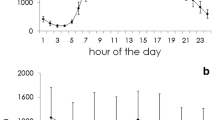Abstract
Previous explanations for the dawn chorus in birds include favourable acoustic conditions1, low foraging profitability reducing the net cost of singing2–4, high risk of territorial intrusion3 and unpredictability in overnight energy requirements leading to spare reserves at dawn4. All these hypotheses assume that males sing either to attract mates or to defend a territory and/or that singing and foraging compete for time5. In the case of the dawn chorus in the great tit Parus major none of these assumptions apply. A peak of song at dawn only appears in late spring when territorial boundaries are established and birds are paired6,7. Conflict between singing and foraging cannot explain why males with more non-foraging time in longer days at northern latitudes roost earlier than birds at southern latitudes and still sing before dawn8. Female emergence from her nest hole terminates the dawn chorus in the great tit9. I show here that changes in the duration of male dawn song are closely related to changes in female fertility.
Similar content being viewed by others
References
1. Henwood, K. & Fabrick, A. Am. Nat. 114, 260-274 (1979). 2. Kacelnik, A. Anim. Behav. 27, 237-242 (1979). 3. Kacelnik, A. & Krebs, J. R. Behaviour 83, 287-309 (1982). 4. NcNamara, J. M., Mace, R. H. & Houston, A. I. Behavl Ecol. Sociobiol. 20, 399-405 (1987). 5. Mace, R. H. Ardea 75, 123-132 (1987). 6. Hinde, R. A. Behaviour SuppL II. 207 (1952). 7. Carson, P. J. & Hunter, M. L. Ibis 121, 481-487 (1979). 8. Mace, R. H. thesis, Univ. Oxford (1987). 9. Mace, R. H. Anim. Behav. 34, 621-622 (1986). 10. Birkhead, T. R., Atkin, L. & M011er, A. P. Behaviour 101, 101-138 (1987). 11. Beecher, M. D. & Beecher, I. M. Science 205, 1282-1285 (1979). 12. Birkhead, T. R. Anim. Behav. 30, 277-283 (1982). 13. Leffelaar, D. & Robertson, R. J. Behavl Ecol. Sociobiol. 16, 73-79 (1984). 14. Bjorkland, M. & Westman, B. Ornis. Scand. 17, 99-107 (1987). 15. Sturkie, P. D. Avion Physiology 2nd edn (Balliere, Tindall & Cassell, London, 1965). 16. Jones, G. Behavl Ecol. Sociobiol. 19, 179-185 (1986). 17. Burger, J. Auk 93, 308-323 (1976). 18. Balthazart, J. J. Zool. 180, 155-173 (1976). 19. Palmgren, P. Ibis 91, 561-576 (1949). 20. Kok, O. B. Condor 73, 348-363 (1971). 21. Eriksson, D. & Wallin, L. Behavl Ecol. Sociobiol. 19, 297-300 (1986). 22. Krebs, J. R. in Evolutionary Ecology (eds Stonehouse, B. & Perrins, C. M.) 47-62 (Macmillan, London, 1977). 23. Catchpole, C. K. in Acoustic Communication in Birds, Vol. I (eds D. E. Kroodsma & E. H. Miller) 297-319 (Academic, London, 1983). 24. Greig-Smith, P. W. Ornis. Scand. 13, 225-231 (1982). 25. M011er, A. P. Oikos 48, 47-54 (1987). 26. Alatalo, R. V., Gustafsson, L. & Lundberg, A. Oikos 42, 41-47 (1984). 27. M011er, A. P. Behavl Ecol. Sociobiol. 17, 401-408 (1985). 28. Cheng, K. M., Burns, J. T. & McKinney, F. Auk 100, 302-310 (1983).
Author information
Authors and Affiliations
Rights and permissions
About this article
Cite this article
Mace, R. The dawn chorus in the great tit Paras major is directly related to female fertility. Nature 330, 745–746 (1987). https://doi.org/10.1038/330745a0
Received:
Accepted:
Issue Date:
DOI: https://doi.org/10.1038/330745a0
- Springer Nature Limited
This article is cited by
-
Sexual selection for both diversity and repetition in birdsong
Nature Communications (2023)
-
Vocal behaviour of Sclater’s Wrens, a duetting Neotropical songbird: repertoires, dawn chorus variation, and song sharing
Journal of Ornithology (2022)
-
No reproductive fitness benefits of dear enemy behaviour in a territorial songbird
Behavioral Ecology and Sociobiology (2022)
-
Effects of temperature and season on birds’ dawn singing behavior in a forest of eastern China
Journal of Ornithology (2021)
-
Dupont’s Lark males start to sing earlier but reduce song rate on full moon dawns
Journal of Ornithology (2020)





